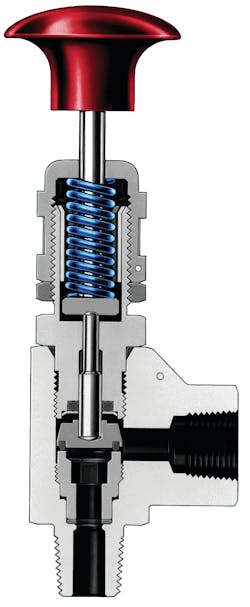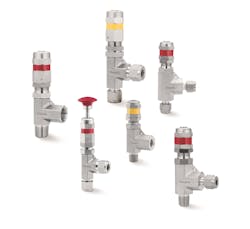Enhancing chemical plant safety with relief valves
Extensive and complex fluid systems throughout chemical plants and refineries comprise countless feet — if not miles — of small-bore tubing. Along that tubing’s entire path, fluids move in multiple directions throughout the facility to serve specific critical functions.
These intricate, pressurized systems can pose significant threats and safety hazards for plant employees, particularly as their complexity increases — and monitoring each part of the system individually can be a daunting task. Therefore, it is especially important for system designers to make safety a priority when selecting components and configuring systems.
One of those key priorities needs to be the inclusion of pressure relief valves at critical points in the system. Such valves are designed to vent off excess pressure buildup in the system, which helps to prevent valve and tubing blowouts, damage to equipment and overall system failures and downtime.
Essential components for safe operations
Relief valves are fail-safe measures that are critical to maintaining plant safety. While fluid systems use pressure regulators to maintain the proper set pressure, the possibility of a pressure spike always exists. This is particularly true in complex systems that frequently encounter high pressures and house potentially dangerous fluids. Without a relief valve, excess pressure has nowhere to go but through the system where it could damage components.
To prevent such damage, fluid systems feature a number of relief valves that must be strategically placed at the design stage. That way, they can be properly situated within the system and set to the maximum allowed pressure for each segment. The relief valves will then open automatically when they sense a higher pressure than their set limit. Doing so allows the excess pressure to immediately escape, bringing the system back to a safe pressure. Plants may need to capture such releases if the system media is toxic, but if the media is safe to allow into the atmosphere, such as with air or nitrogen, the plant may not need to capture the relieved pressure.
Relief valve options
The type of relief valve to use depends on the fluid system design and its operation, with four common types of valves to choose from:
- Proportional relief valves: As pressure increases above the set pressure or falls below the set pressure, these valves open and close gradually.
- Proportional safety-relief valves: Operating in the same way as proportional relief valves, these valves also carry Pressure Equipment Directive (PED) certification for use as safety valves to accommodate specifications.
- Bleed and purge valves: For instrumentation devices like multivalve manifolds or gauge valves, bleed valves can be used to vent signal line pressure to atmosphere before removing an instrument or to assist in control device calibrations. Purge valves are manual bleed, vent or drain valves.
- Medium-pressure relief valves: For simple, reliable, over-pressure protection, medium-pressure proportional relief valves can be used in a variety of general applications.
What leads to relief valve activations
Numerous conditions may lead to overpressurization in large-scale fluid systems, but the primary culprits fit the following categories:
- Procedural errors. Simple operator error is a common cause of system overpressurization. A technician may accidentally open a wrong valve that causes downstream system pressure to rise. Another operator may calibrate the system improperly. Or someone may install the wrong type of pressure regulator — or even install it backwards — during routine maintenance. Proper training can help reduce the possibility of these errors, but relief valves serve as an essential fail-safe to accommodate human errors that lead to excessive pressure buildups.
- Component Wear. As fluid system components wear due to actuations and exposure to caustic chemicals, it may be more difficult to control system pressure over time. In such cases, relief valves serve as the last line of defense to prevent unsafe pressure buildups.
- Contamination. Dirty or contaminated fluids can prevent pressure regulators from functioning properly and keeping pressure at the proper levels. For example, particulates can prevent the regulator’s seal from sealing completely, which allows excess pressure to creep past it and increase pressure downstream. Relief valves are important in these situations so the unwanted pressure can be released before it becomes a safety hazard.
- Loss of power. When electronic controls are used to manage complex systems, potential hazards can materialize if the plant loses power unexpectedly. Certain components may not operate correctly without power, leaving relief valves to prevent system overpressurization and maintain system safety.
Where to install relief valves
Relief valves should typically be installed within the following applications to maintain plant safety:
- High-pressure systems. Relief valves are an essential safety element in high-pressure fluid system applications that exceed a certain psi. High-quality small-bore tube fittings should be used for such applications to protect against the potential dangers of overpressurization. In addition, relief valves should be used as a supplemental safety measure.
- Toxic fluids or chemical applications. Relief valves are also essential in applications in which escaping system pressure would cause an immediate plant safety threat. In such applications, the relief valves can be configured to capture any vented pressure and media instead of releasing it into the atmosphere. That way technicians can safely dispose the escaped fluid.
- Sensitive equipment. Protecting sensitive analytical equipment from overpressurization is one of the most important roles pressure relief valves can play. Damage to online analyzers, for example, is likely if they are subjected to higher pressures than their rated limits. Such analyzers are meant to sample fluids directly from main processes to verify quality control, so you want to keep them in top shape. Pairing a regulator with a properly rated and set relief valve will help to ensure that pressure from the main process is sufficiently reduced by the time fluids reach the analyzer.
The proper placement of pressure relief valves throughout industrial fluid systems is vital to enhancing overall plant safety. These placements should be considered at the time of initial system design to avoid the need for future system configurations. Plants can also enhance safety in their designs by avoiding the intermixing of tube fittings, eliminating unnecessary system complexities and remembering to consider operational factors like vibration. Plants are much easier to operate safely when system designers pay attention to these factors and use relief valves judiciously.
Optimizing system designs for safety
To realize the safest system design possible, it can help to work closely with a qualified fluid system component supplier. The right partner can connect you with fluid system design specialists who fully understand the chemical and refining industries and who have a track record of success. They will be able to provide advice on the optimal locations for relief valves and how to choose the best tube fitting components for the system. In addition, such suppliers can offer a wide array of advice on enhancing plant safety at all stages of the fluid system.
Shaji Arumpanayil is product manager for Swagelok Company.
Swagelok Company
About the Author
Shaji Arumpanayil
Product Manager, Swagelok Company
Shaji Arumpanayil is Product Manager for Swagelok Company.


